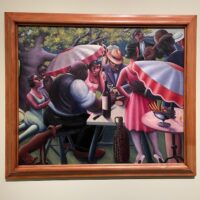Julian Peters has done Poe, Rimbaud, Frost, Keats, Dylan Thomas, Wordsworth, Oscar Wilde, Villon, Yeats, Sassoon, and plenty of others — and they’re all damn well done — so why not T.S. Eliot?
‘Dear Willy’ Tells a War Tale of Love and Hope
The letters that Hollywood director William Wyler and his wife Talli wrote to each other during World War II are the basis of a new documentary directed by Taylor Alexander.
Underground Railroad: Walt Whitman Bears Witness
… to “the runaway slave” in his most famous poem, “Song of Myself,” which first appeared untitled in his self-published collection Leaves of Grass, in 1855.
One More Missive from the Department of Letters
By popular demand, here’s another letter from Nelson Algren, this time a big fat gossipy one apparently in reply to questions that Roger Groening must have posed.
Not a Bad Way to Start the Week
Cleaning out one of my desk drawers, I came across a long-forgotten file folder containing a ream of letters from Nelson Algren to Roger Groening. They are a motherlode of humor, wit, and edifying entertainment, and from time to time I will post more of his letters to Roger..
‘The glide begins, direction down …’
THE HAPPY GIRL
The glide begins, direction down,
the happy girl has gone to hell.
She lies in bed, her mouth an O,
her breath a whisper of dissent.
They Come at Night
WHISPERS
the face
that launched
a thousand ships
has sailed
and not in beauty
Tipped by a Friend and Glad to Know
“Thought this would give you a smile,” he wrote. “Look whose book shows up in the first pic of this article.” It appears from the photo that my biography of the Hollywood director William Wyler, “A Talent for Trouble,” turned up in the secondhand book sale of the late Robert Gottlieb’s private library.
War Crime Outcomes —
Two Coverups in the Slaughterhouse of War
From the podcast IN THE DARK: “On November 19, 2005, a small group of U.S. Marines killed 24 civilians in Haditha, Iraq. The case against them would become one of the most high-profile war-crimes prosecutions in American history, and then it would all fall apart. … No one was held accountable.” Why not?
On March 16, 1968, more than 500 Vietnamese men, women, and children in the village of Mi Lai were slaughtered by a platoon of U.S. soldiers. It became known as the Mi Lai massacre. The soldiers were led by Lieutenant William Calley. He was later court-martialed and convicted of murder after an Army cover-up.
Leave It to Flaubert to Tell It as It Is
Three excerpts from the recently published edition of ‘The Letters of Gustave Flaubert,’ edited and translated by Francis Steegmullers, seem to me an apt commentary on our own time.
Malaise . . . In the Middle of Nowhere
Not helped
by late disasters
and no idea
of what to do
but write these lines
and think of better times.
Just in Time for Independence Day
America’s top shitholer goes
whole hog at the public trough,
and never mind the rest of us,
because that is the hog’s nature. …
BEAT SCENE No. 110
Latest Issue Filled With Rich Tales
About Brion Gysin, Paul Bowles, William Burroughs, Allen Ginsberg, Neal Cassidy and Anne Murphy, Charles Bukowski, Herbert Huncke, Jack Kerouac, Gregory Corso, Ed Sanders, Tuli Kupferberg, Milton Klonsky, Alice Notley, Bernard Kops, Neeli Cherkovski, Emmett Grogan and the Diggers, Martin Bax, the influence of Gertrude Stein, the death of Joan Volmer, and more …
Whimsy and Philosophy: Pictures at an Artist’s Studio
On a visit to Paul Zelevansky’s studio in Manhattan, I took some pictures of the works he had there on display. These are some of the ones I photographed. I post them here without commentary other than their titles for you to decide how they strike you.
With Apologies to Gogol
Suddenly I felt
while massaging my skin
the skeleton within. …
Artists of ‘Harlem Renaissance’ at Metropolitan Museum
Glad I got to the Met for a glimpse before it becomes hotter ‘n hell. Although the museum was jammed, the show itself was comfortable. It was also much larger than I expected. I hadn’t realized how many accomplished painters there were among the Harlem group. For example, I had never heard of Archibald Motley Jr. who I thought pretty much sets the exquisite tone of the show, though by no means exclusively.
Käthe Kollwitz at MoMA
Finally got to see this intimate, brooding retrospective.

















